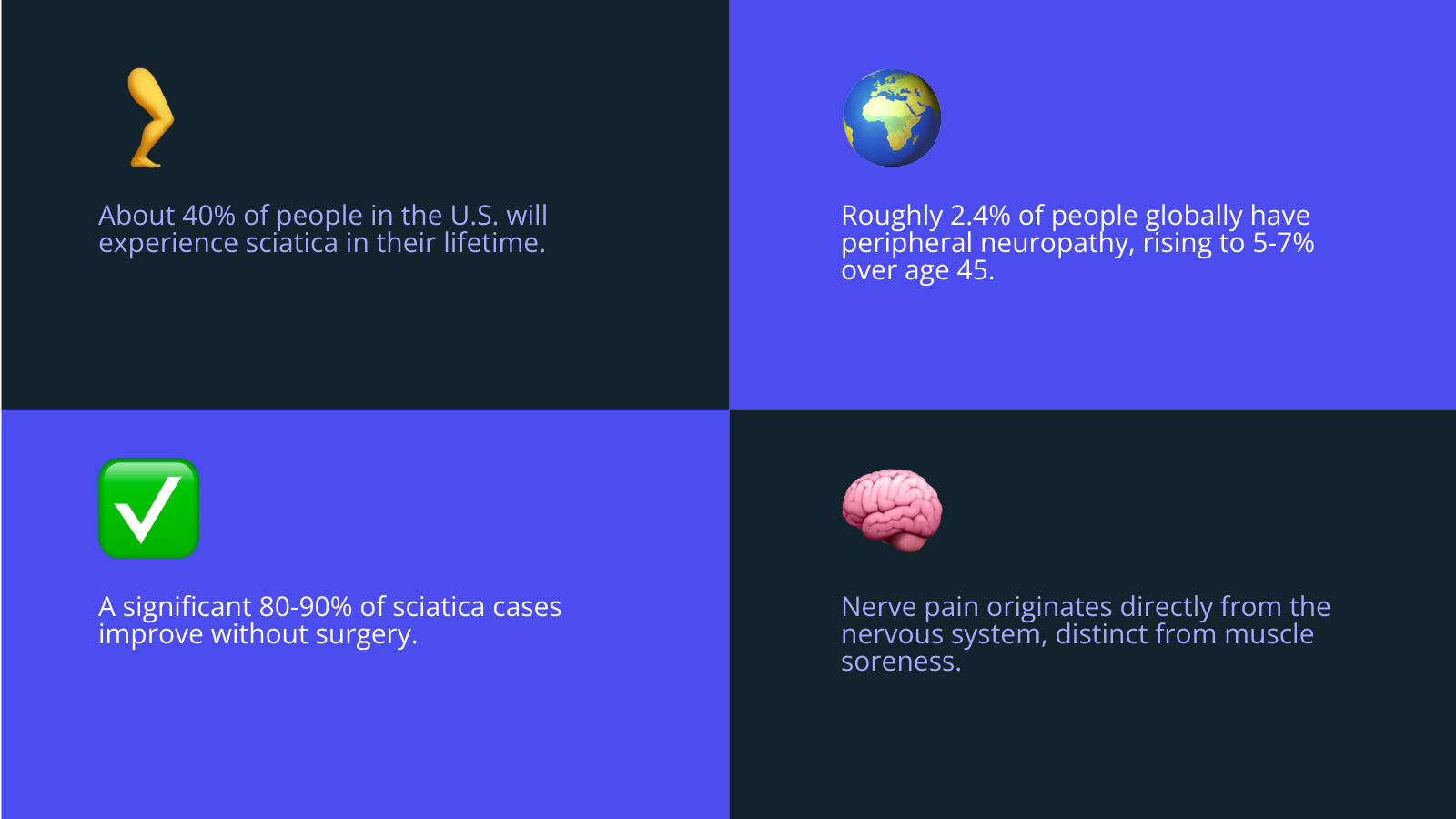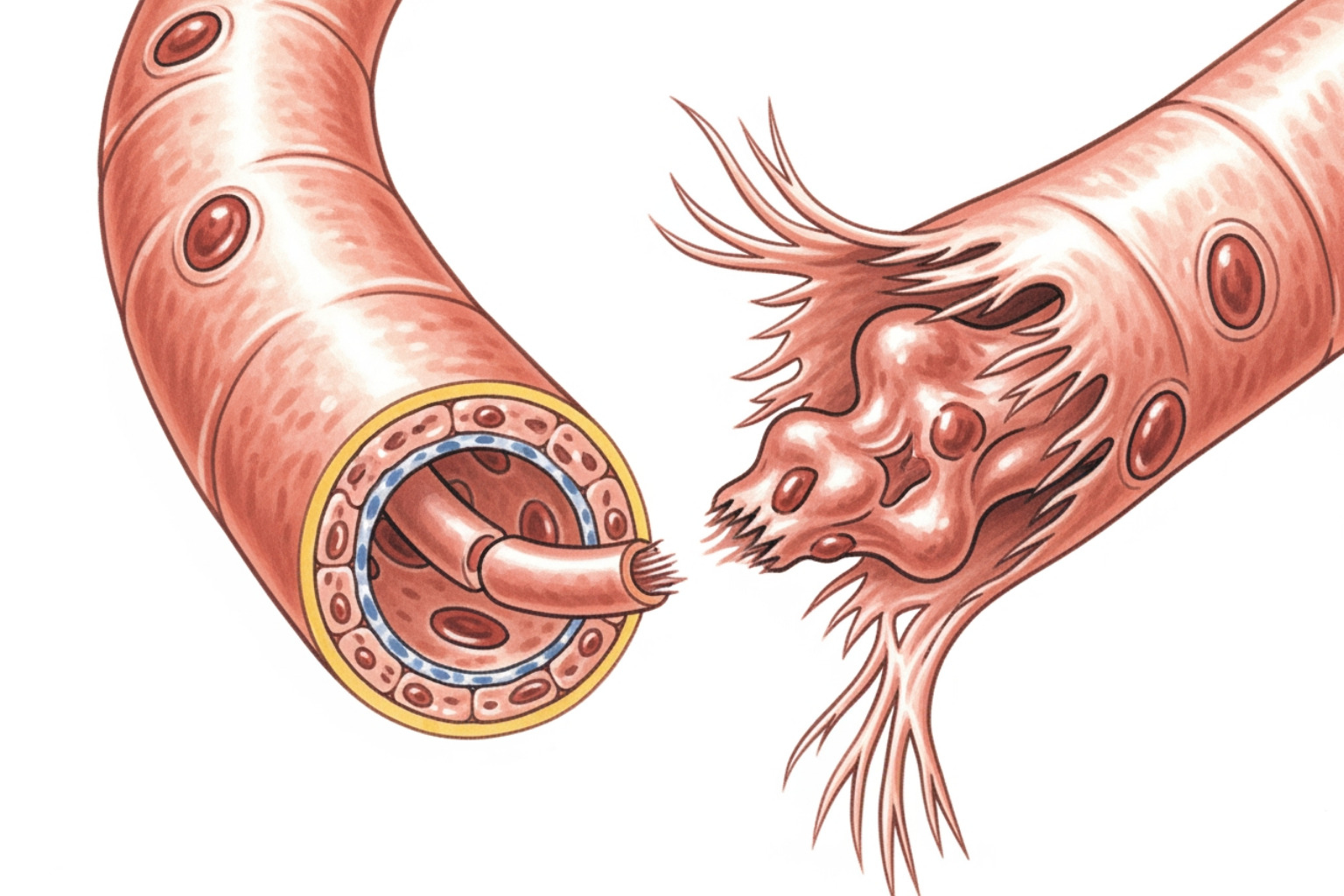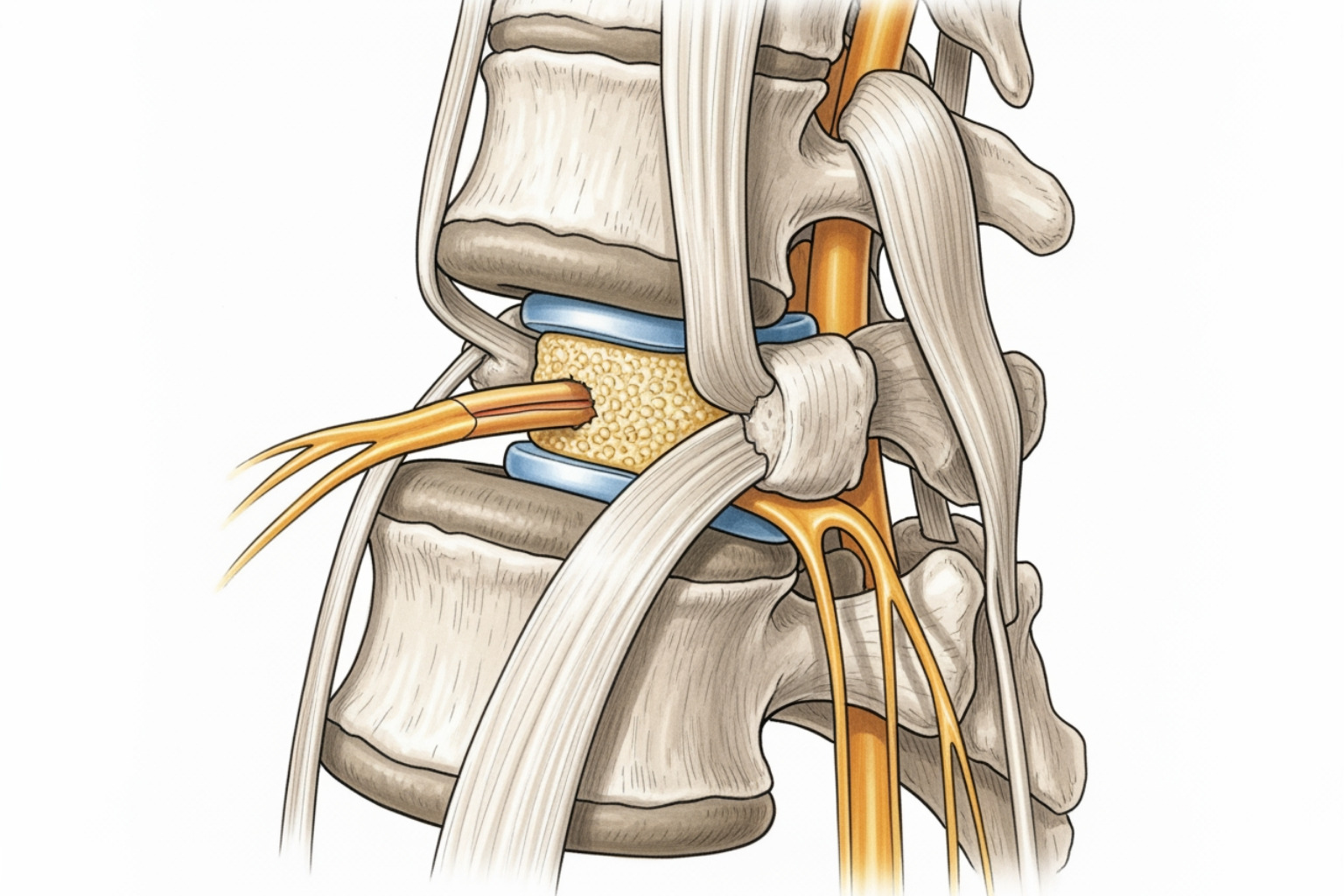When Every Step Reminds You: Understanding Leg Nerve Pain
Nerve pain in leg can feel like a sharp, shooting sensation, a persistent burn, or tingling that disrupts your daily life. If you're experiencing this discomfort, you're not alone.
Quick Answer: What Causes Nerve Pain in the Leg?
- Sciatica – Compression of the sciatic nerve, often from a herniated disc or spinal stenosis.
- Peripheral Neuropathy – Nerve damage commonly from diabetes, vitamin deficiencies, or autoimmune conditions.
- Pinched Nerves – Compression from tight muscles (like piriformis syndrome) or bone spurs.
- Tarsal Tunnel Syndrome – Nerve compression in the ankle.
- Peripheral Artery Disease – Reduced blood flow that affects nerve function.
Most Common Symptoms:
- Shooting, electric shock-like pain
- Burning or tingling sensations
- Numbness or "pins and needles"
- Muscle weakness or foot drop
Leg nerve pain is a widespread issue. About 40% of people in the U.S. experience sciatica during their lifetime (Cleveland Clinic), and roughly 2.4% of the general population has peripheral neuropathy, a figure that rises to 8% for people over 55 (Cleveland Clinic).
Unlike muscle soreness, nerve pain originates from the nervous system itself due to compression, inflammation, or damage. The pain can be sudden or gradual, radiating from your lower back or creating a burning sensation in your calf or foot.
The good news is that most cases of nerve pain in the leg improve with conservative treatment. Studies show 80-90% of people with sciatica get better without surgery (Mayo Clinic, 2023). Understanding the cause is the first step toward relief.
I'm Tony Enrico, and through my work with Neuropasil, I've dedicated myself to helping people find relief from nerve pain in leg conditions. My mission is to empower you with knowledge and natural solutions to restore your freedom of movement.

Simple nerve pain in leg word guide:
Understanding the Signals: What is Nerve Pain in the Leg?
Think of your nervous system as your body's communication network. When something disrupts these lines, the messages get scrambled, and nerve pain in leg can appear.
Nerve pain in leg, or neuropathic pain, is different from muscle soreness (nociceptive pain). Muscle pain is a straightforward "ouch" message from injured tissue. Nerve pain is more like a false alarm; the nerves themselves are damaged or compressed and send confused signals that your brain interprets as pain. A light touch might feel like burning, or standing up could trigger an electric shock.
This malfunction can happen when a herniated disc squeezes a nerve, or when a condition like diabetes damages nerve fibers. The location and quality of your pain provide clues about which nerve is affected. To learn more, you can read about decoding nerve pain.

What are the Symptoms of Nerve Pain in the Leg?
Nerve pain manifests differently for everyone, but some telltale signs point to nerve involvement:
Shooting or electric shock pain: Often described as lightning bolts or sudden jolts running down the leg, following a specific nerve path.
Burning sensations: This feels like a fire under the skin, often in the calf or sole of the foot, and can worsen at night.
Tingling or "pins and needles": Medically known as paresthesia, this is the familiar feeling of a limb "falling asleep," but it persists due to nerve damage or compression.
Numbness or loss of sensation: This creates a strange paradox where the leg can feel both numb and painful. It can be dangerous, as you might not notice injuries.
Muscle weakness: Damaged nerves can't properly signal muscles, making it hard to stand on tiptoes or causing your leg to give out.
Foot drop: The most severe symptom, where you can't lift the front of your foot, causing it to drag. This requires prompt medical attention.
Most people experience a combination of these symptoms. For a deeper look, check out our guide on peripheral neuropathy symptoms.
Distinguishing Nerve Pain from Common Muscle Soreness
Is it a tough workout or something more? Here’s how to tell the difference:
Quality of Pain: Muscle soreness is a deep, dull ache. Nerve pain is sharp, shooting, electric, burning, or tingling, often radiating in a specific pattern.
Timing and Triggers: Muscle soreness peaks 48-72 hours after exercise and improves with light activity. Nerve pain can appear suddenly, persist for weeks or months, and may worsen with certain positions like sitting or bending.
When should you be concerned? Normal muscle soreness is temporary. See a doctor for pain that lasts more than a week, worsens, or is accompanied by numbness, tingling, or weakness. Seek immediate medical attention for severe pain that prevents walking, sudden muscle weakness, loss of balance, foot drop, or numbness in the groin area, as these are red flags for serious nerve issues.
Uncovering the Root Cause: Common Causes and Types of Leg Nerve Pain
Finding the right solution for nerve pain in leg starts with identifying the root cause. The pain can stem from a mechanical issue (a nerve being physically squeezed) or a systemic condition affecting nerves throughout your body. Let's explore the most common culprits.

Compression-Related Causes (Pinched Nerves)
Sometimes, nerve pain in leg is caused by something pressing on a nerve, like a kinked garden hose. This pressure disrupts nerve function, sending out pain signals.
- Sciatica: This is a symptom, not a condition, caused by irritation or compression of the sciatic nerve. The pain radiates from the lower back down one leg.
- Herniated Discs: These are a primary cause of sciatica. The rubbery cushions between your vertebrae can bulge or rupture, pressing on nerve roots.
- Spinal Stenosis: A narrowing of the spaces within your spine, common with aging, which can squeeze the nerves traveling to your legs.
- Piriformis Syndrome: A muscle deep in the buttock tightens or spasms, compressing the sciatic nerve that runs nearby.
- Tarsal Tunnel Syndrome: The ankle's version of carpal tunnel, where a nerve is compressed on the inside of the ankle, causing pain in the ankle and sole of the foot.
For strategies to address nerve compression, see our guide on relieving a pinched nerve and the Mayo Clinic's overview of sciatica.
Systemic and Medical Conditions
Sometimes the problem is a body-wide condition affecting nerve health, which can be more complex to treat.
- Peripheral Neuropathy: An umbrella term for damage to nerves outside the brain and spinal cord. It affects about 2.4% of the general population, rising to 8% for those over 55 (Cleveland Clinic).
- Diabetes: The leading cause of peripheral neuropathy. High blood sugar damages nerves, typically starting in the feet and legs in a "stocking-glove" pattern. Learn more about diabetic neuropathy.
- Vitamin Deficiencies: Nerves require vitamins B12, B6, B1, and E to function. Deficiencies can lead to nerve damage.
- Autoimmune Diseases: Conditions like lupus or rheumatoid arthritis can cause the immune system to attack nerve tissues.
- Infections and Toxins: HIV, Lyme disease, shingles, heavy metals, and certain medications (like chemotherapy) can all harm peripheral nerves.
- Peripheral Artery Disease (PAD): Reduced blood flow to the legs starves nerves of oxygen, causing pain and numbness, especially with activity.
How Sciatica Differs from Other Types of Leg Nerve Pain
Understanding the difference between sciatica and peripheral neuropathy is key to getting the right treatment.
Sciatica is almost always a unilateral (one-sided) issue. The pain is sharp and shooting, radiating from the lower back down one leg. It's caused by a specific compression point in the lower spine, such as a herniated disc.
Peripheral Neuropathy is typically a bilateral (two-sided) condition. It often starts in the toes and feet and moves upward symmetrically. The sensations are usually tingling, numbness, or burning, resulting from generalized nerve damage due to systemic issues like diabetes or vitamin deficiencies.
Your Roadmap to Relief: Approaches for Nerve Pain in Leg
When nerve pain in leg disrupts your life, you want relief. Encouragingly, most cases improve with conservative, non-surgical approaches. Research shows that 80-90% of people with sciatica get better without surgery (Mayo Clinic, 2023). The best strategy often involves combining several methods.

At-Home and Lifestyle Strategies
Simple daily habits can form the foundation of your recovery.
- Gentle Movement and Stretching: Light activity like walking keeps blood flowing to nerves. Gentle stretches for the lower back, hamstrings, and glutes can release pressure on compressed nerves.
- Heat and Cold Therapy: Use ice packs for the first 48-72 hours to calm inflammation. Afterward, switch to heat to increase blood flow and relax tight muscles.
- Posture Correction: Slouching adds strain to your spine. Practice good posture when sitting and standing. See these Tips for good posture from Cleveland Clinic.
- Healthy Weight and Movement: Maintaining a healthy weight reduces pressure on your spine. Avoid long periods of sitting or standing by taking regular breaks to move and stretch.
- Quit Tobacco: Nicotine reduces blood supply to spinal tissues, impairing healing. Quitting is a crucial step in conquering nerve pain in leg.
For more natural approaches, explore our guide on natural nerve pain solutions.
Over-the-Counter and Topical Solutions
For relief right where it hurts, topical solutions are an excellent choice. Topical pain relief creams deliver active ingredients directly to the affected area without the systemic side effects of oral medications.
The effectiveness lies in the ingredients. Menthol creates a cooling sensation that distracts your nervous system from pain. Aloe Vera offers anti-inflammatory and soothing properties. Urea helps these ingredients penetrate deeper into the skin, carrying relief where it's needed most.
At Neuropasil, we formulated our cream with these ingredients to offer fast-acting, targeted relief. Our customers rely on Neuropasil for neuropathy, sciatica, and other aches and pains. For a complete guide, see our resource on nerve pain relief creams.
Supportive and Therapeutic Interventions
When home remedies aren't enough, professional guidance can help.
- Physical Therapy: A therapist can design a personalized program to strengthen your core, improve flexibility, and teach proper body mechanics to prevent recurrence.
- Mind-Body Techniques: Practices like yoga and meditation can calm your nervous system and change how your brain processes pain signals.
- Acupuncture: A clinical trial showed acupuncture can reduce pain and improve function in patients with chronic sciatica, with benefits lasting up to a year (Zhang, Y., et al., 2024).
- Medications: Over-the-counter NSAIDs (ibuprofen, naproxen) can reduce inflammation. For more severe pain, a doctor might prescribe medications like gabapentin, muscle relaxants, or certain antidepressants.
- Spinal Injections: Corticosteroid injections near the affected nerve can provide short-term relief by reducing inflammation.
If conservative treatments don't provide relief after a few weeks, or if symptoms worsen, it's time for a deeper medical evaluation, which may include imaging like an MRI or a consultation with a specialist.
Prevention, Prognosis, and When to See a Doctor
While not all nerve pain in leg can be prevented, you can significantly reduce your risk for many common causes with thoughtful lifestyle choices. Understanding the outlook and knowing when to see a doctor are key parts of your recovery.
Can Nerve Pain in the Leg Be Prevented?
Think of prevention as building a protective shield around your nerves. Here are some of the best defenses:
- Regular Exercise: Low-impact activities like walking, swimming, or cycling keep your body strong and flexible without stressing your spine.
- Core Strengthening: Strong abdominal and back muscles act as a natural brace for your spine, reducing the risk of nerve compression.
- Proper Lifting Techniques: Always squat and lift with your legs, keeping objects close to your body. Avoid twisting while lifting.
- Good Posture: Maintain good posture throughout the day, whether sitting, standing, or sleeping. An ergonomic chair and a supportive mattress can make a big difference.
- Manage Underlying Conditions: If you have diabetes, diligent blood sugar management is critical to preventing or slowing diabetic neuropathy.
- Avoid Smoking: Nicotine restricts blood flow to your spinal discs and nerves, hindering their ability to heal.
- Healthy Weight Management: Extra pounds put additional strain on your spine and lower body joints.
Outlook and When to Seek Medical Attention
The prognosis for nerve pain in leg depends on the cause, severity, and how quickly it's addressed. Many cases of sciatica, for instance, improve dramatically within weeks to months. As mentioned, 80% to 90% of people with sciatica get better without surgery (Mayo Clinic, 2023).
For chronic conditions like diabetic neuropathy, the goal is often management rather than a complete cure. Early treatment is crucial; waiting too long can make recovery harder and may lead to chronic pain.
Seek immediate medical attention for these "red flag" symptoms (Cleveland Clinic):
- Sudden or rapidly worsening muscle weakness.
- Loss of bowel or bladder control. This is a medical emergency that could signal Cauda Equina Syndrome.
- Numbness or weakness below the knee accompanied by bladder or bowel issues.
- Severe pain following a violent injury like a car accident or fall.
- Unexplained fever with back pain, which could indicate an infection.
Consult your healthcare provider for any pain that persists or worsens after a week or two of home care, or if it significantly impacts your daily life. Early intervention gives you the best chance at a full recovery.
Frequently Asked Questions about Leg Nerve Pain
When you're dealing with nerve pain in leg, you want clear, practical answers. Here are some of the most common questions we hear.
What is the fastest way to relieve leg nerve pain?
While there's no single instant cure, combining these strategies can bring fast relief:
- Cold Packs: For acute pain (the first 48-72 hours), apply an ice pack wrapped in a towel for 15-20 minutes at a time to reduce inflammation and numb the area.
- Topical Creams: Solutions like Neuropasil deliver active ingredients like Menthol and Aloe directly to the source of pain, offering targeted relief often within minutes.
- Gentle Stretching: If the pain is from compression, simple stretches for your lower back or hamstrings can sometimes provide immediate, temporary relief. Stop if any movement makes the pain worse.
- Over-the-Counter Pain Relievers: NSAIDs like ibuprofen or naproxen can reduce inflammation and typically start working within an hour.
See a doctor for fast relief if your pain is sudden and severe, or accompanied by muscle weakness or loss of bowel/bladder control, as this could indicate a serious issue requiring urgent care.
Can nerve pain in the leg go away on its own?
Yes, in many cases, nerve pain in leg can resolve on its own. This is especially true for mild sciatica from a herniated disc, which often improves within a few weeks to months as inflammation subsides. Studies show that 80% to 90% of people with sciatica get better without surgery (Mayo Clinic, 2023).
However, the outlook depends on the cause. A pinched nerve from muscle tension may resolve once the muscle relaxes. In contrast, chronic conditions like peripheral neuropathy from diabetes require ongoing management to control symptoms, as the underlying nerve damage may not be fully reversible.
Even if pain can go away on its own, don't ignore persistent or worsening symptoms. If your pain hasn't improved after two weeks of home care, consult a healthcare professional to avoid the risk of permanent damage.
What vitamin is good for nerve pain in the leg?
Specific nutrients are vital for nerve health. If you have nerve pain in leg, addressing a vitamin deficiency could make a real difference.
B-Vitamins: These are superstars for nerve health. Vitamin B12 is essential for maintaining the protective coating around nerves (myelin sheath). A study on Vitamin B12 for nerve pain highlights its importance (Al-Musharaf, S., 2020). Vitamin B6 supports nerve signaling, and Vitamin B1 (Thiamine) is crucial for nerve energy.
Vitamin E: This powerful antioxidant protects nerves from damage.
Alpha-Lipoic Acid: This antioxidant has shown promise in managing symptoms of diabetic neuropathy.
Crucially, consult with your doctor before taking supplements. They can run tests to identify deficiencies and recommend safe dosages. Taking too much of certain vitamins (like B6) can be harmful. Your doctor can ensure supplementation is a safe and effective part of your treatment plan.
Take Control of Your Leg Pain Today
Living with nerve pain in leg doesn't have to be your permanent reality. The journey to relief begins with understanding your symptoms and their cause. Accurate diagnosis is the key to effective treatment, whether it's addressing a compressed sciatic nerve or managing diabetic neuropathy.
The vast majority of people—80-90% of those with sciatica—find relief with conservative treatments (Mayo Clinic, 2023). A combination of approaches often works best: gentle stretches, good posture, and targeted therapies.
We understand the frustration of finding a solution that works. That's why we developed Neuropasil's formula with Aloe, Urea, and Menthol—to provide natural, fast-acting topical relief when you need it most. Our cream offers targeted soothing for neuropathy, sciatica, and general nerve discomfort.
Don't let pain control your life. Take action by starting with at-home strategies and consulting a healthcare professional when needed. You deserve to move through life without discomfort, and with the right knowledge, that freedom is within reach.
For more insights on managing nerve pain, explore more articles on nerve pain on our blog.
Sources
This guide on nerve pain in leg draws from trusted medical institutions and peer-reviewed research to ensure all information is accurate and credible. The primary sources used include:
Al-Musharaf, S. (2020). Vitamin B12 for the treatment of painful peripheral neuropathy. This PubMed-indexed study was referenced for nutritional approaches to nerve pain.
-
Cleveland Clinic. The following patient resources provided key statistics and information on prevention and symptoms:
Mayo Clinic. (2023). Sciatica - Symptoms and Causes. This resource provided data on the prognosis for sciatica.
Zhang, Y., et al. (2024). Acupuncture for Chronic Sciatica: A Randomized Clinical Trial. This study from JAMA Internal Medicine was cited for evidence on alternative treatments.













